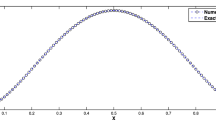Abstract
A new approach is proposed for the numerical solution of boundary value one-dimensional problem of advection-diffusion equation which arises, among others, in air pollution modeling. Since the problem is posed in an unbounded interval we use a log-transformation to confine the computational region. We discuss the well-posedness of the new problem and the properties of its solution. We derive a positive finite volume difference scheme. Some results from computational experiments are presented.
Similar content being viewed by others
References
Chernogorova, T., Valkov, R.: Finite volume difference scheme for a degenerate parabolic equation in the zero-coupon bond pricing. Math. Comput. Modell. 54, 2659–2671 (2011)
Chernogorova, T., Vulkov, L.: Finite volume difference scheme for a transformed stationary air pollution problem. Amer. Inst. Phys. 1497, 176–183 (2012)
Dang, Q.A., Ehrhardt, M.: Adequate numerical solution of air pollution problems by positive difference schemes on unbounded domains. Math. Comp. Modell. 44, 834–856 (2006)
Dang, Q.A., Ehrhardt, M.: On Dirac delta sequences and their generating functions. Appl. Math. Lett. 25(12), 2385–2390 (2012)
Dang, Q.A., Ehrhardt, M., Tran, G. L., Le, D.: In: Bodine, C.G. (ed.) On the Numerical Solution of Some Problems of Enveronmental Pollution, Air Pollution Research Advances, pp. 171–200. Nova Science Publishers, Inc. (2007)
Zlatev, Z., Dimov, I.: Computational and Numerical Challenges in Environmental Modeling, p. 373. Elsevier, Amsterdam (2006)
Farago, I., Korotov, S., Szabo, T.: Non-negativity preservation of the discrete nonstationary heat equation in 1D and 2D. J. Appl. Math. 3, 60–81 (2010)
Gilbarg, D., Trudinger, N.: Elliptic Partial Differential Equations of Second Order, 3rd edn., pp. 523. Springer-Verlag, Berlin Heidelberg (2001)
Haslinger, J., Miettinen, M., Panagiotopoulos, P.D.: Finite Element Method for Hemivariational Inequalities, pp. 267. Kluwer Academic Publisher, Dordrecht, The Netherlands (1999)
Kufner, A.: Weighted Sobolev spaces, pp. 152. Wiley, New York (1985)
Lanser, D., Verwer, J.G.: Analysis of operator splitting for advection-diffusion-reaction problems from air pollution modelling. J. Comp. Appl. Math. 111, 201–216 (1999)
Ladyzenskaja, O.A., Solonnikov, V.A., Ural’tseva, N.N.: Linear and quasilinear equations of parabolic type. Amer. Math. Soc. Transl. Monographs 23, 648 (1968)
Marchuk, G.I.: Mathematical Models in Environmental Problems, Studies in Mathematics and its Applications, vol. 16, p. 217. North Holland (1986)
Matus, P.: The maximum principle and some of the applications. Comput. Methods Appl. Math. 2, 50–91 (2002)
Miller, J.J.H., Wang, S: A New non-conforming Petrov-Galerkin finite element method with triangular elements for a singularly perturbed advection-diffusion problem. IMA J. Numer. Anal. 14, 257–276 (1994)
Morton, K.W.: Numerical Solution of Convection-Diffusion Problems, p. 372. Chapman and Hall, London (1996)
Oleinik, O.A., Radkevich, E.V.: Second Order Equations with Nonnegative Characteristic Form, p. 259. AMS Plenum Press, New York (1973)
Samarskii, A.A.: The Theory of Difference Schemes, p. 786. Marcel Dekker, New York (2001)
Tornberg, A.K., Engquist, E.: Numerical approximations of PDEs with singularities. J. Comp. Phys. 19, 527–552 (2003)
Valkov, R.: Finite volume method for the Black-Scholes equation transformed on finite interval. Amer. Inst. Phys. 1497, 76–83 (2012)
Wang, S.: A novel finite volume method for Black-Scholes equation governing option pricing. IMA. J. Numer. Anal. 24, 699–720 (2004)
Zlatev, Z., Havasi, A., Farago, I.: Influence of climatic changes on pollution levels in Hungary and its surrounding countries. Atmosphere 2, 201–221 (2011)
Author information
Authors and Affiliations
Corresponding author
Rights and permissions
About this article
Cite this article
Chernogorova, T., Lubin Vulkov, L. Fitted finite volume positive difference scheme for a stationary model of air pollution. Numer Algor 70, 171–189 (2015). https://doi.org/10.1007/s11075-014-9940-y
Received:
Accepted:
Published:
Issue Date:
DOI: https://doi.org/10.1007/s11075-014-9940-y




